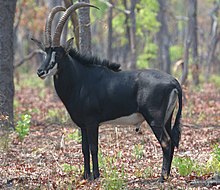Bovid
Bovids are a family of even-toed ungulate mammals.[1] The word "Bovidae" is comes from Latin bos, "ox".[2] Even-toed ungulates are said to have "cloven hooves": that means their hooves are formed from two toes. They evolved early in the Miocene period.
| Bovidae | |
|---|---|

| |
| Sable antelope | |
| Scientific classification | |
| Kingdom: | |
| Phylum: | |
| Class: | |
| Order: | |
| Family: | Bovidae Gray, 1821
|
There 143 living species in this family. They include cattle, goats, sheep and antelopes. The family is widespread, living in all continents except the southern continents South America, Australia and Antarctica.
They are all ruminants, with the double stomach system of digesting vegetation, which is most efficient. The family originated in the Miocene, and is now very successful. Their success is probably helped by their digestive system. The group includes the three domestic animals cows, sheep and goats.
Taxonomy
change- Family Bovidae
- Subfamily Aepycerotinae (one genus: the impala)
- Subfamily Alcelaphinae (one tribe and four genera: wildebeest and relatives)
- Subfamily Antilopinae (three tribes and 15 genera: gazelles and relatives)
- Subfamily Bovinae (three tribes and ten genera: cattle, bisons etc.)
- Subfamily Caprinae (three tribes and 13 genera: goats and sheep)
- Subfamily Cephalophinae (three genera: duikers)
- Subfamily Hippotraginae (three genera: antelopes)
- Subfamily Panthelopinae (the Tibetan antelope)
- Subfamily Peleinae (the grey rhebok)
- Subfamily Reduncinae (two genera: more antelopes)
References
change- ↑ Grubb P. 2005. Family Bovidae. In Wilson D.E. & Reeder D.M (eds) Mammal Species of the World: a taxonomic and geographic reference. 3rd ed, Johns Hopkins University Press. pp. 637–722. ISBN 978-0-8018-8221-0. OCLC 62265494.
- ↑ "Bovidae". Merriam-Webster online dictionary. Retrieved 7 October 2014.